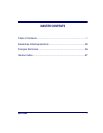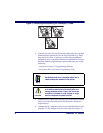
User’s Guide 5
Verifying
Scanner
Operation
Once a charged battery has been installed in the scanner, scan the sam-
ple bar codes in the back of this manual that correspond to the symbol-
ogies your scanner is programmed to read. If unsure how to do this,
see the section on How to Scan in this manual. The system may signal
with one or a combination of indicators depending upon how the scan-
ner and Base Station are programmed to respond (see LED and Beeper
Indications for details). If your scanner fails to read a sample bar code of
a symbology it’s programmed to read, turn to the section titled, Trouble-
shooting.
Power Supply Models require either a Listed class II or class III with a Limited Power
Source (LPS).
For the safety certification to be valid, class III input power sources
must be IEC/EN60950-1 (EN 60335-series, EN 60065 or relevant)
approved.
Input: 100 - 240 VAC Output: 9 - 10 VDC
Max. Current: 2.0 A Max. Power: 20 W
For 4-slot battery charger:
Input: 100 - 240 VAC Output: 12 VDC
Max. Current: 2.5 A Max. Power: 30 W
Connecting the
Base Station to
the Host
Terminal
1. Connect the I/F cable to the Base Station (see Figure 2A). The
I/F cable is inserted into the connector and the cable retainer
clip is rotated over the cable overmold until the retainer snaps
in place (see Figure 2B). To disconnect the cable, push in on the
retainer (away from the catch on the plastic wall) to release it
and enable it to swing upward, allowing the cable to be pulled
free (see Figure 2C).
NOTE
It is important that the interface (I/F) cable be con-
nected to the Base Station prior to applying power
to the system. This is because the interface type
(RS-232, IBM, Keyboard Wedge, etc.) is selected by
the Base Station subject to the I/F cable it is con-
nected to at the time of power-up.


















